Diagenesis of Cenomanian–Early Turonian and the Control of Carbonate Reservoirs in the Northern Central Arabian Basin
Abstract
:1. Introduction
2. Geological Setting
3. Materials and Methods
4. Results
4.1. Diagenetic Environment
4.1.1. Marine Environment
4.1.2. Meteoric Environment
4.1.3. Burial Environment
4.2. Diagenesis
4.2.1. Dissolution
4.2.2. Cementation
4.2.3. Micritization
4.2.4. Dolomitization
4.2.5. Compaction and Pressure Solution
5. Discussion
5.1. Effects of Dissolution and Cementation on Reservoirs
5.2. Effects of Micritization on Reservoirs
5.3. Effects of Dolomitization on Reservoirs
5.4. Effects of Compaction and Pressure Solution on Reservoirs
5.5. Comprehensive Diagenetic Model
6. Conclusions
- (1)
- Three diagenetic environments were identified in the Cenomanian–Early Turonian based on texture, structure, cement, and crystal form and size, which were marine environment, meteoric environment, and burial environment. The vadose zone of meteoric environments is characterized by intense dissolution, where there developed a large amount of secondary pores due to the shallow depositional environment.
- (2)
- Six diageneses were identified in the Cenomanian–Early Turonian according to residual bioclastic, secondary pores, calcite quantity, dolomite form and size, and stylolite, which were dissolution, cementation, micritization, dolomitization, compaction, and pressure solution. The diagenesis mechanism and characteristics of performance were analyzed. A micritization model and a dolomitization model in burrows were established.
- (3)
- During the Cenomanian–Early Turonian, dissolution in the meteoric environment was the most beneficial to the reservoir and cementation was the most unfavorable. The combination of them was classified into three types based on the cement content of 30% and 70%, which had a clear control on the reservoir’s physical properties and the different combinations of dissolution and cementation corresponding to physical properties are clearly distinguishable. Micritization is detrimental to the petrophysical properties, and is the main micrite origin of the reservoir deposited in a high energy environment. Dolomitization is widely developed in burrows, resulting in the physical properties of the burrows being higher than those of the substrate. Compaction and pressolution are destructive to the reservoir’s physical properties. A comprehensive diagenetic model of the Cenomanian–Early Turonian was established.
Author Contributions
Funding
Data Availability Statement
Acknowledgments
Conflicts of Interest
References
- Bromhead, A.D.; Van Buchem, F.S.P.; Simmons, M.D.; Davies, R.B. Sequence stratigraphy, palaeogeography and petroleum plays of the Cenomanian–Turonian succession of the Arabian Plate: An updated synthesis. J. Pet. Geol. 2022, 45, 119–161. [Google Scholar] [CrossRef]
- Zhong, Y.; Tan, X.; Zhao, L.; Guo, R.; Li, F.; Jin, Z.; Chen, Y.; Xiao, D. Identification of facies-controlled eogenetic karstification in the Upper Cretaceous of the Halfaya oilfield and its impact on reservoir capacity. Geol. J. 2019, 54, 450–465. [Google Scholar] [CrossRef]
- Alsharhan, A.S.; Nairn, A.E.M. A review of the Cretaceous formations in the Arabian Peninsula and Gulf: Part II. Mid-Cretaceous (Wasia Group) stratigraphy and paleogeography. J. Pet. Geol. 1988, 11, 89–112. [Google Scholar] [CrossRef]
- Al-Khafaji, A.J.; Hakimi, M.H.; Najaf, A.A. Organic geochemistry characterisation of crude oils from Mishrif reservoir rocks in the southern Mesopotamian Basin, South Iraq: Implication for source input and paleoenvironmental conditions. Egypt. J. Pet. 2018, 27, 117–130. [Google Scholar] [CrossRef]
- Zhou, C.; Zhang, Q.; Yang, P.; Duan, H. Main controlling factors of hydrocarbon accumulation in Mesopotamia Basin. Pet. Geol. Exp. 2013, 35, 296–301. [Google Scholar]
- Mahdi, T.A.; Mustafa, J. Facies Modelling of Mishrif Formation in Selected Wells of Tuba Oil Field, Southern Iraq. Int. J. Adv. Eng. Res. Sci. 2018, 5, 237355. [Google Scholar] [CrossRef]
- Al-Ameri, T.K.; Al-Khafaji, A.J.; Zumberge, J. Petroleum system analysis of the Mishrif reservoir in the Ratawi, Zubair, North and South Rumaila oil fields, southern Iraq. GeoArabia 2009, 14, 91–108. [Google Scholar] [CrossRef]
- Aqrawi, A.A.M.; Thehni, G.A.; Sherwani, G.H.; Kareem, B.M.A. Mid-Cretaceous rudist-bearing carbonates of the Mishrif Formation: An important reservoir sequence in the Mesopotamian Basin, Iraq. J. Pet. Geol. 1998, 21, 57–82. [Google Scholar] [CrossRef]
- Sadooni, F.N.; Aqrawi, A.A.M. Cretaceous sequence stratigraphy and petroleum potential of the Mesopotamian Basin, Iraq. SEPM Spec. Publ. 2000, 69, 315–334. [Google Scholar]
- Abdelhady, A.A.; Farouk, S.; Ahmad, F.; Elamri, Z.; Al-Kahtany, K. Impact of the late Cenomanian sea-level rise on the south Tethyan coastal ecosystem in the Middle East (Jordan, Egypt, and Tunisia): A quantitative eco-biostratigraphy approach. Palaeogeogr. Palaeoclimatol. Palaeoecol. 2021, 574, 110446. [Google Scholar] [CrossRef]
- Jaballah, J.; Negra, M.H.; Reijmer, J.J.G. Middle Cenomanian–Turonian sequence stratigraphy of central-southern Tunisia: Regional and global control on depositional patterns. Cretac. Res. 2020, 111, 104446. [Google Scholar] [CrossRef]
- Van Buchem, F.S.; Razin, P.; Homewood, P.W.; Oterdoom, W.H.; Philip, J. Stratigraphic organization of carbonate ramps and organic-rich intrashelf basins: Natih Formation (middle Cretaceous) of northern Oman. AAPG Bull. 2002, 86, 21–53. [Google Scholar]
- Ali, M.Y.; Farid, A. Cretaceous–neogene structural evolution of Se abu dhabi, united Arab Emirates. J. Pet. Geol. 2016, 39, 221–245. [Google Scholar] [CrossRef]
- Alavi, M. Regional stratigraphy of the Zagros fold-thrust belt of Iran and its proforeland evolution. Am. J. Sci. 2004, 304, 1–20. [Google Scholar] [CrossRef]
- Grélaud, C.; Razin, P.; Homewood, P.W.; Schwab, A.M. Development of incisions on a periodically emergent carbonate platform (Natih Formation, Late Cretaceous, Oman). J. Sediment. Res. 2006, 76, 647–669. [Google Scholar] [CrossRef]
- Nasser, M.E. Stratigraphic Sequence and Basin development of the Mishrif Formation in Selected Oil fields in the Mesopotamian Zone, Southeastern Iraq. Int. J. Adv. Eng. Res. Sci. 2018, 5, 237462. [Google Scholar] [CrossRef]
- Saber, S.G.; Salama, Y.F.; Scott, R.W.; Abdel-Gawad, G.I.; Aly, M.F. Cenomanian-Turonian rudist assemblages and sequence stratigraphy on the North Sinai carbonate shelf, Egypt. GeoArabia 2009, 14, 113–134. [Google Scholar] [CrossRef]
- Mahdi, T.A.; Aqrawi, A.A.M. Role of facies diversity and cyclicity on the reservoir quality of the mid-Cretaceous Mishrif Formation in the southern Mesopotamian Basin, Iraq. Geol. Soc. Lond. Spec. Publ. 2018, 435, 1–21. [Google Scholar] [CrossRef]
- Al-Mimar, H.S.; Awadh, S.M.; Al-Yaseri, A.A.; Yaseen, Z.M. Sedimentary units-layering system and depositional model of the carbonate Mishrif reservoir in Rumaila oilfield, Southern Iraq. Model. Earth Syst. Environ. 2018, 4, 1449–1465. [Google Scholar] [CrossRef]
- Liu, H.; Tian, Z.; Liu, B.; Guo, R.; Yang, D.; Deng, Y.; Yu, Y.; Shi, K. Pore types, origins and control on reservoir heterogeneity of carbonate rocks in Middle Cretaceous Mishrif Formation of the West Qurna oilfield, Iraq. J. Pet. Sci. Eng. 2018, 171, 1338–1349. [Google Scholar] [CrossRef]
- Zhang, L.; Li, R.; Deng, H.; Fu, M.; Hu, L.; Guo, X.; Xie, X.; Zhao, C. Identification, Distribution Characteristics, and Effects on Production of Interlayers in Carbonate Reservoirs: A Case Study from the Cretaceous Mishrif Formation in Halfaya Oilfield, Iraq. J. Pet. Sci. Eng. 2021, 202, 108571. [Google Scholar] [CrossRef]
- Li, R.; Chen, Q.; Deng, H.; Fu, M.; Hu, L.; Xie, X.; Zhang, L.; Guo, X.; Fan, H.; Xiang, Z. Quantitative evaluation of the carbonate reservoir heterogeneity based on production dynamic data: A case study from Cretaceous Mishrif formation in Halfaya oilfield, Iraq. J. Pet. Sci. Eng. 2021, 206, 109007. [Google Scholar] [CrossRef]
- Al-Musawi, F.A.; Idan, R.M.; Salih, A.L.M. Reservoir characterization, Facies distribution, and sequence stratigraphy of Mishrif Formation in a selected oilfield, South of Iraq. J. Phys. Conf. Ser. 2020, 1660, 012073. [Google Scholar] [CrossRef]
- Grant, S.R.; Hughes, M.J.; Olatoke, O.J.; Philip, N. Stochastic inversion by trace matching for carbonate reservoir property prediction: A Mishrif Reservoir case study. Lead. Edge 2019, 38, 27–34. [Google Scholar] [CrossRef]
- Cantrell, D.L.; Shah, R.A.; Ou, J.; Xu, C.; Phillips, C.; Li, X.L.; Hu, T.M. Depositional and diagenetic controls on reservoir quality: Example from the upper Cretaceous Mishrif Formation of Iraq. Mar. Pet. Geol. 2020, 118, 104415. [Google Scholar] [CrossRef]
- Chafeet, H.A.; Raheem, M.K.; Dahham, N.A. Diagenesis processes impact on the carbonate Mishrif quality in Ratawi oilfield, southern Iraq. Model. Earth Syst. Environ. 2020, 6, 2609–2622. [Google Scholar] [CrossRef]
- Hussain, S.A.; Al-Obaidi, M.; Khwedim, K.; Ahmad, K. Facies Architecture, Diagenesis and Paleoceanography of Mishrif (Late Cretaceous) in Selected Wells of West Qurna Oil Field, Southern Iraq. J. Phys. Conf. Ser. 2020, 1664, 012137. [Google Scholar] [CrossRef]
- Wang, R.; Wang, Z.; Osumanu, A.; Zhang, G.; Li, B.; Lu, Y. Grid density overlap hierarchical algorithm for clustering of carbonate reservoir rock types: A case from Mishrif Formation of West Qurna-1 oilfield, Iraq. J. Pet. Sci. Eng. 2019, 182, 106209. [Google Scholar] [CrossRef]
- Kelishami, S.B.A.; Mohebian, R. Petrophysical rock type (PRT) and evaluation of Cenomanian–Santonian lithostratigraphic units in southwest of Iran. Carbonates Evaporites 2021, 36, 13–29. [Google Scholar] [CrossRef]
- Awadeesian, A.M.; Al-Jawed, S.N.A.; Saleh, A.H.; Sherwani, G.H. Mishrif carbonates facies and diagenesis glossary, South Iraq microfacies investigation technique: Types, classification, and related diagenetic impacts. Arab. J. Geosci. 2015, 8, 10715–10737. [Google Scholar] [CrossRef]
- Qiao, Z.; Janson, X.; Shen, A.; Zheng, J.; Zeng, H.; Wang, X. Lithofacies, architecture, and reservoir heterogeneity of tidal-dominated platform marginal oolitic shoal: An analogue of oolitic reservoirs of Lower Triassic Feixianguan Formation, Sichuan Basin, SW China. Mar. Pet. Geol. 2016, 76, 290–309. [Google Scholar] [CrossRef]
- Qiao, Z.; Yu, Z.; She, M.; Pan, L.; Zhang, T.; Li, W.; Shen, A. Progress on ancient ultra-deeply buried marine carbonate reservoir in China. J. Palaeogegraphy 2023, 25, 1257–1276, (In Chinese with English Abstract). [Google Scholar]
- Sharland, P.R.; Casey, D.M.; Davies, R.B.; Simmons, M.D.; Sutcliffe, O.E. Arabian Plate Sequence Stratigraphy. GeoArabia 2004, 9, 199–214. [Google Scholar] [CrossRef]
- Han, H.; Guo, R.; Wang, J.; Qin, G.; Sun, X.; Yu, Y.; Su, H.; Gao, Y. Sequence stratigraphic framwork and sedimentary evolution of the Cretaceous in Southern Iraq. Earth Sci. Front. 2023, 30, 122–138, (In Chinese with English Abstract). [Google Scholar]
- De Periere, M.D.; Durlet, C.; Vennin, E.; Caline, B.; Boichard, R.; Meyer, A. Influence of a major exposure surface on the development of microporous micritic limestones-Example of the Upper Mishrif Formation (Cenomanian) of the Middle East. Sediment. Geol. 2017, 353, 96–113. [Google Scholar] [CrossRef]
- Chen, P.; Guo, L.; Li, C.; Tong, Y. Karstification characteristics of the Cenomanian-Turonian Mishrif Formation in the Missan Oil Fields, southeastern Iraq, and their effects on reservoirs. Front. Earth Sci. 2022, 16, 435–445. [Google Scholar] [CrossRef]
- Mehrabi, H.; Rahimpour-Bonab, H. Paleoclimate and tectonic controls on the depositional and diagenetic history of the Cenomanian–early Turonian carbonate reservoirs, Dezful Embayment, SW Iran. Facies 2014, 60, 147–167. [Google Scholar] [CrossRef]
- Jodeyri-Agaii, R.; Rahimpour-Bonab, H.; Tavakoli, V.; Kadkhodaie-Ilkhchi, R.; Yousefpour, M.R. Integrated approach for zonation of a mid-Cenomanian carbonate reservoir in a sequence stratigraphic framework. Geol. Acta Int. Earth Sci. J. 2018, 16, 321–337. [Google Scholar]
- Newport, R.; Segura, M.; Redfern, J.; Hollis, C. The interaction of tectonics, climate and eustasy in controlling dolomitization: A case study of Cenomanian–Turonian, shallow marine carbonates of the Iberian Basin. Sedimentology 2020, 67, 2223–2247. [Google Scholar] [CrossRef]
- Hollis, C. Diagenetic controls on reservoir properties of carbonate successions within the Albian–Turonian of the Arabian Plate. Pet. Geosci. 2011, 17, 223–241. [Google Scholar] [CrossRef]
- Ahmad, K.I.; Hussain, S.A.; Al-Obaidi, M. Paleoceanographic reconstruction of Upper Cretaceous, black shale succession, Northeastern Iraq using Geochemical proxies to indicate paleoredox and paleoenvironment conditions. Diyala J. Pure Sci. 2018, 14, 237–264. [Google Scholar]
- Wang, H.; Shi, K.; Ma, Y.; Liu, B.; Song, X.; Ge, Y.; Liu, H.; Hoffmann, R.; Immenhauser, A. Control of depositional and diagenetic processes on the reservoir properties of the Mishrif Formation in the AD oilfield, Central Mesopotamian Basin, Iraq. Mar. Pet. Geol. 2021, 132, 105202. [Google Scholar] [CrossRef]
- He, Z.; Jin, Z.; Li, S.; Bai, G.; Lv, X.; Guo, J.; Gao, J.; Yin, J.; Li, Y.; Zheng, D. Prototypes, modifications, and hydrocarbon enrichment variations in basins influenced by Tethyan evolution: A comparative analysis of the Persian Gulf Basin and the Sichuan Basin. Sci. China Earth Sci. 2023, 66, 2871–2897, (In Chinese with English Abstract). [Google Scholar] [CrossRef]
- Aqrawi, A.A.M.; Gof, J.C.; Horbury, A.D.; Sadooni, F.N. The Petroleum Geology of Iraq; Buck Scientific Press: Beaconsfield, UK, 2010. [Google Scholar]
- Sherwani, G.H.M.; Aqrawi, A.A.M. Lithostratigraphy and environmental considerations of Cenomanian-Early Turonian shelf carbonates (Rumaila and Mishrif formation) of Mesopotamian basin, central and southern Iraq (Abastract). AAPG Bull. 1987, 71, 614. [Google Scholar]
- Kalanat, B.; Vaziri-Moghaddam, H.; Bijani, S. Depositional history of the uppermost Albian–Turonian Sarvak Formation in the Izeh Zone (SW Iran). Int. J. Earth Sci. 2021, 110, 305–330. [Google Scholar] [CrossRef]
- Li, F.; Li, L.; Chen, J. Characteristics of high flow zones and a balanced development strategy of a thick bioclastic limestone reservoir in the Mishrif Formation in X Oilfield, Iraq. Energies 2023, 16, 1451. [Google Scholar] [CrossRef]
- Veizer, J.; Ala, D.; Azmy, K.; Bruckschen, P.; Buhl, D.; Bruhn, F.; Garden, G.; Diener, A.; Ebneth, S.; Godderis, Y.; et al. 87Sr/86Sr, δ13C and δ18O evolution of Phanerozoic seawater. Chem. Geol. 1999, 161, 59–88. [Google Scholar] [CrossRef]
- Kim, S.T.; O’Neil, J.R. Equilibrium and nonequilibrium oxygen isotope effects in synthetic carbonates. Geochim. Cosmochim. Acta 1997, 61, 3461–3475. [Google Scholar] [CrossRef]
- Gu, Q.; Xing, F.; Wen, J.; Liu, Z.; Feng, S. Research progress on carbonate factory. Acta Sedimentol. Sin. 2022, 7, 1–30, (In Chinese with English Abstract). [Google Scholar]
- Qiao, Z.; Shao, G.; Luo, X.; Cao, P.; Sun, X.; Shen, A. Genetic classification and large-scale reservoir development law of burial dolomite: Cognition based on LA-ICP-MS trace elemental mapping and U-Pb dating. Nat. Gas Ind. 2021, 41, 46–56, (In Chinese with English Abstract). [Google Scholar]
- Ehrenberg, S.N.; Walderhaug, O.; Bjorlykke, K. Carbonate porosity creation by mesogenetic dissolution: Reality or illusion? AAPG Bull. 2012, 96, 217–233. [Google Scholar] [CrossRef]
- Wang, M.; Chen, C. In-situ Simulations and Experiments of Deep Carbonate Rocks and Its Implications for Exploration: Take Permian Samples in Northeast Sichuan as an Example. Mar. Orig. Pet. Geol. 2018, 23, 10–16, (In Chinese with English Abstract). [Google Scholar]
- Qiao, Z.; Shen, A.; Zhang, S.; Hu, A.; Liang, F.; Luo, X.; Shao, G.; Wang, Y.; Zhao, J.; Cao, P.; et al. Origin of giant Ordovician cavern reservoirs in the Halahatang oil field in the Tarim Basin, northwestern China. AAPG Bull. 2023, 107, 1105–1135. [Google Scholar] [CrossRef]
- Salamon, K.; Kołodziej, B.; Löser, H. Diverse nature of ubiquitous microborings in Cenomanian corals (Saxonian Cretaceous Basin, Germany). Cretac. Res. 2021, 126, 104888. [Google Scholar] [CrossRef]
- Gingras, M.K.; Pemberton, S.G.; Muelenbachs, K.; Machel, H. Conceptual models for burrow-related, selective dolomitization with textural and isotopic evidence from the Tyndall Stone, Canada. Geobiology 2004, 2, 21–30. [Google Scholar] [CrossRef]
- Baniak, G.M.; Gingras, M.K.; Pemberton, S.G. Reservoir characterization of burrow-associated dolomites in the Upper Devonian Wabamun Group, Pine Creek gas field, central Alberta, Canada. Mar. Pet. Geol. 2013, 48, 275–292. [Google Scholar] [CrossRef]
- Qiao, Z.; Shen, A.; Liang, F. Magnesium isotope-based forming process of large sized burial dolomite: A case study of the Penglaiba Formation in Tarim basin. Acta Geol. Sin. 2023, 97, 2293–2310, (In Chinese with English Abstract). [Google Scholar]
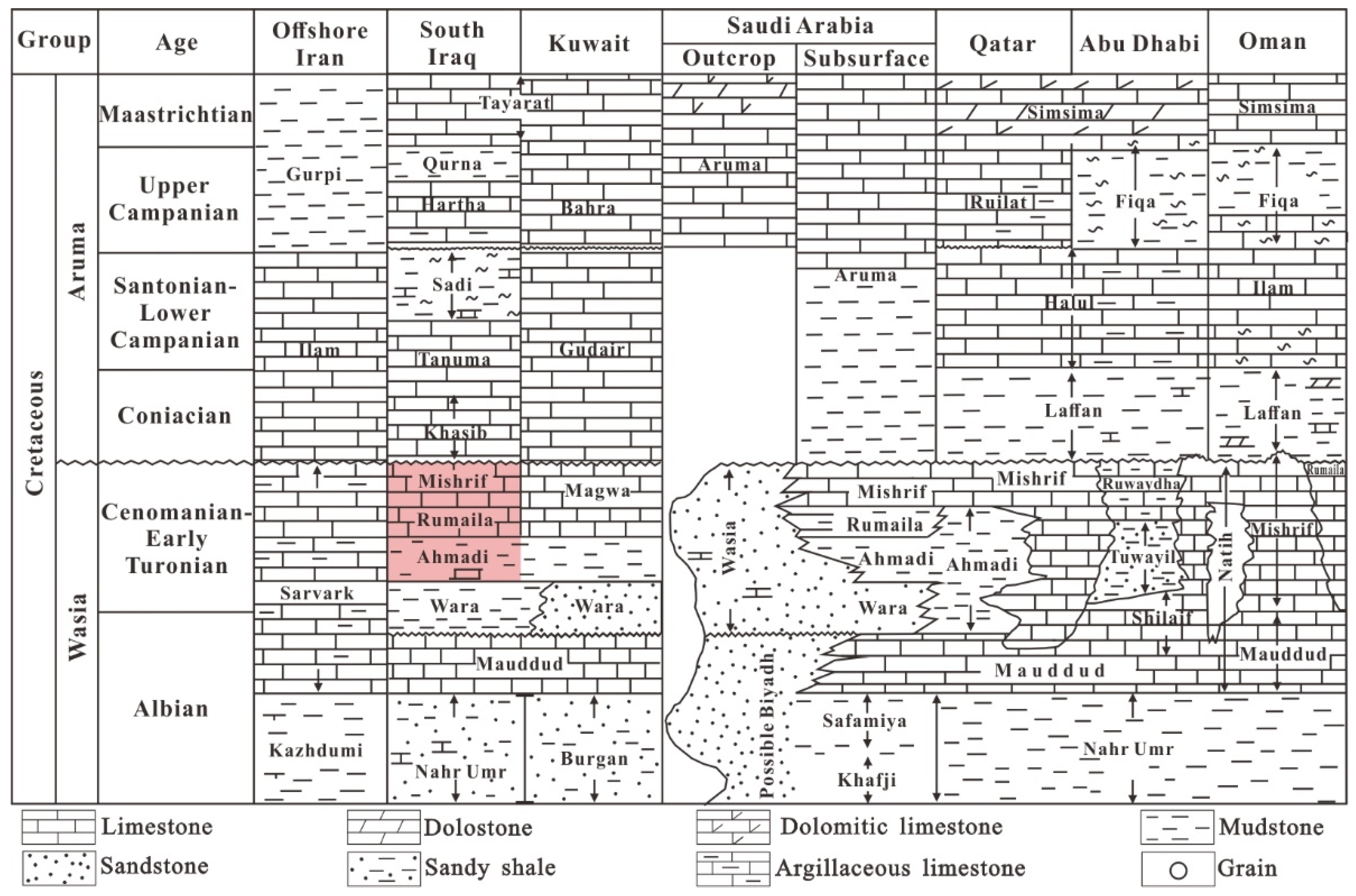

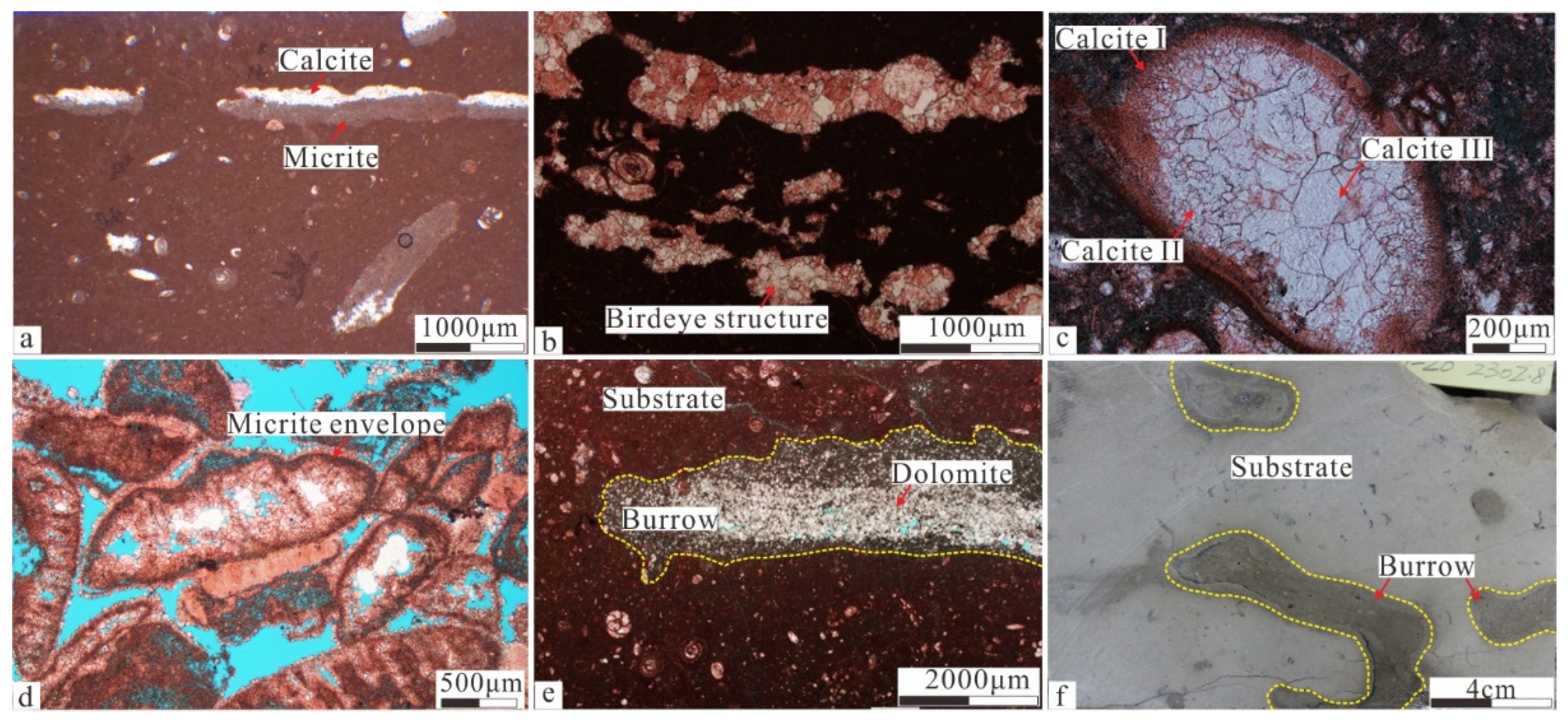

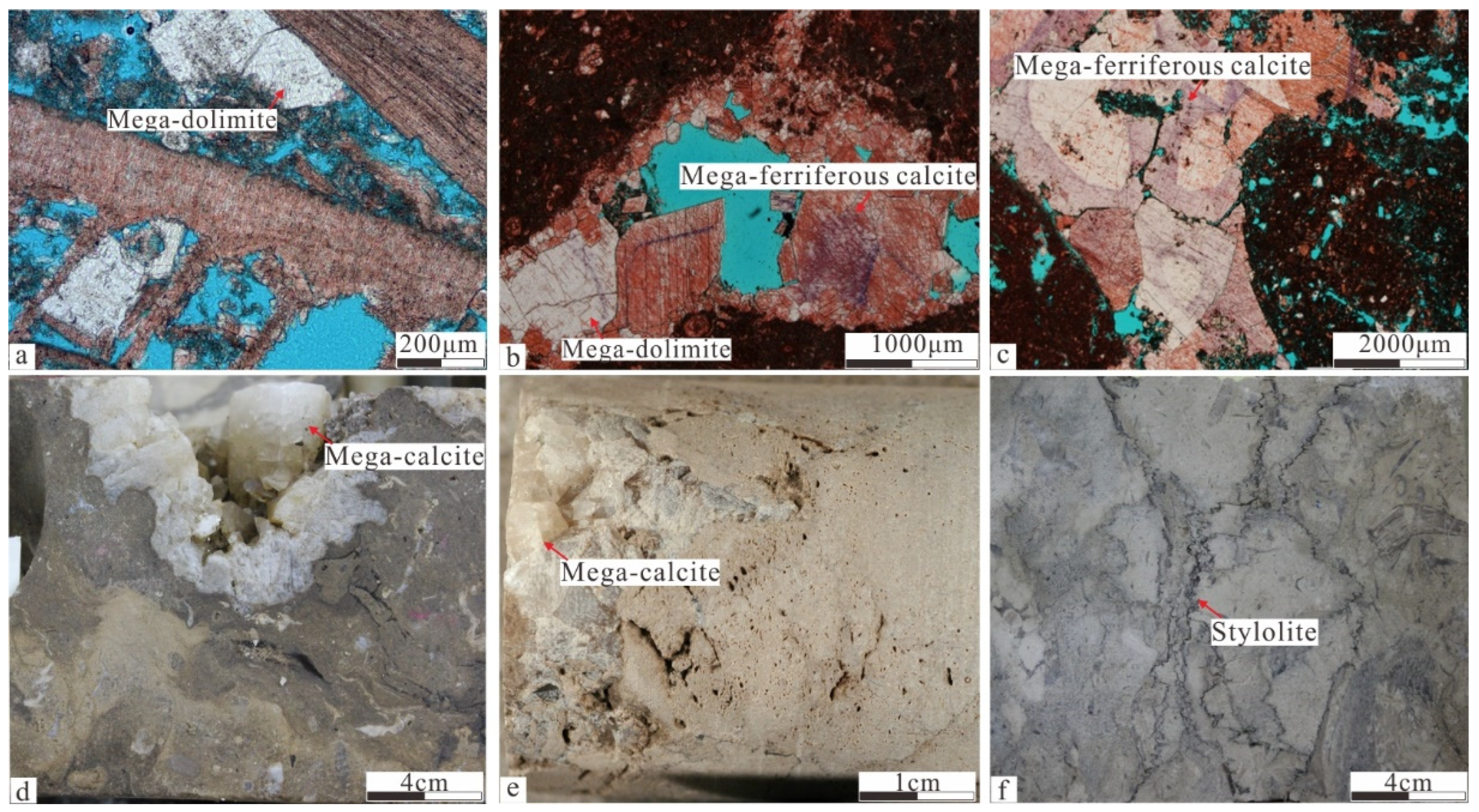


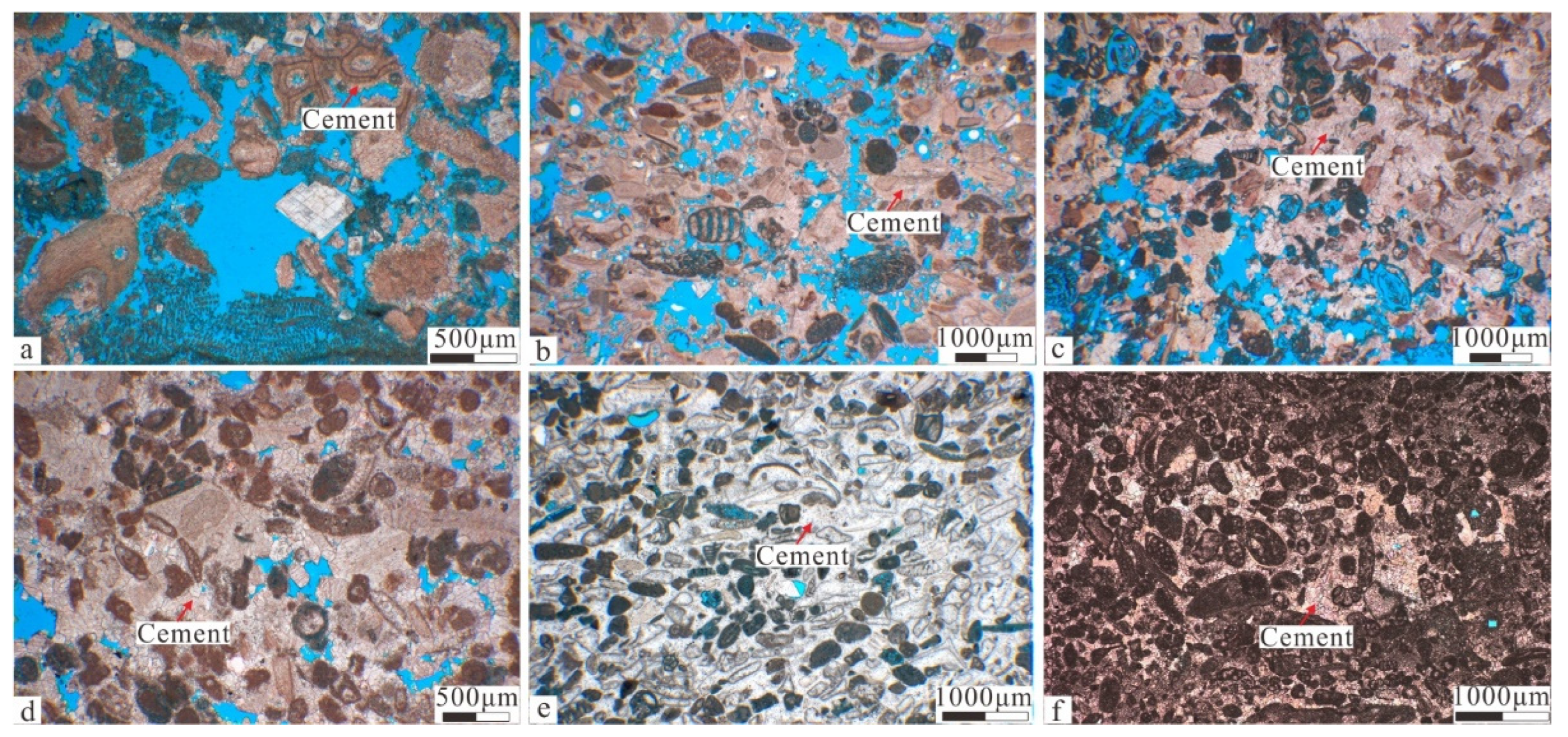
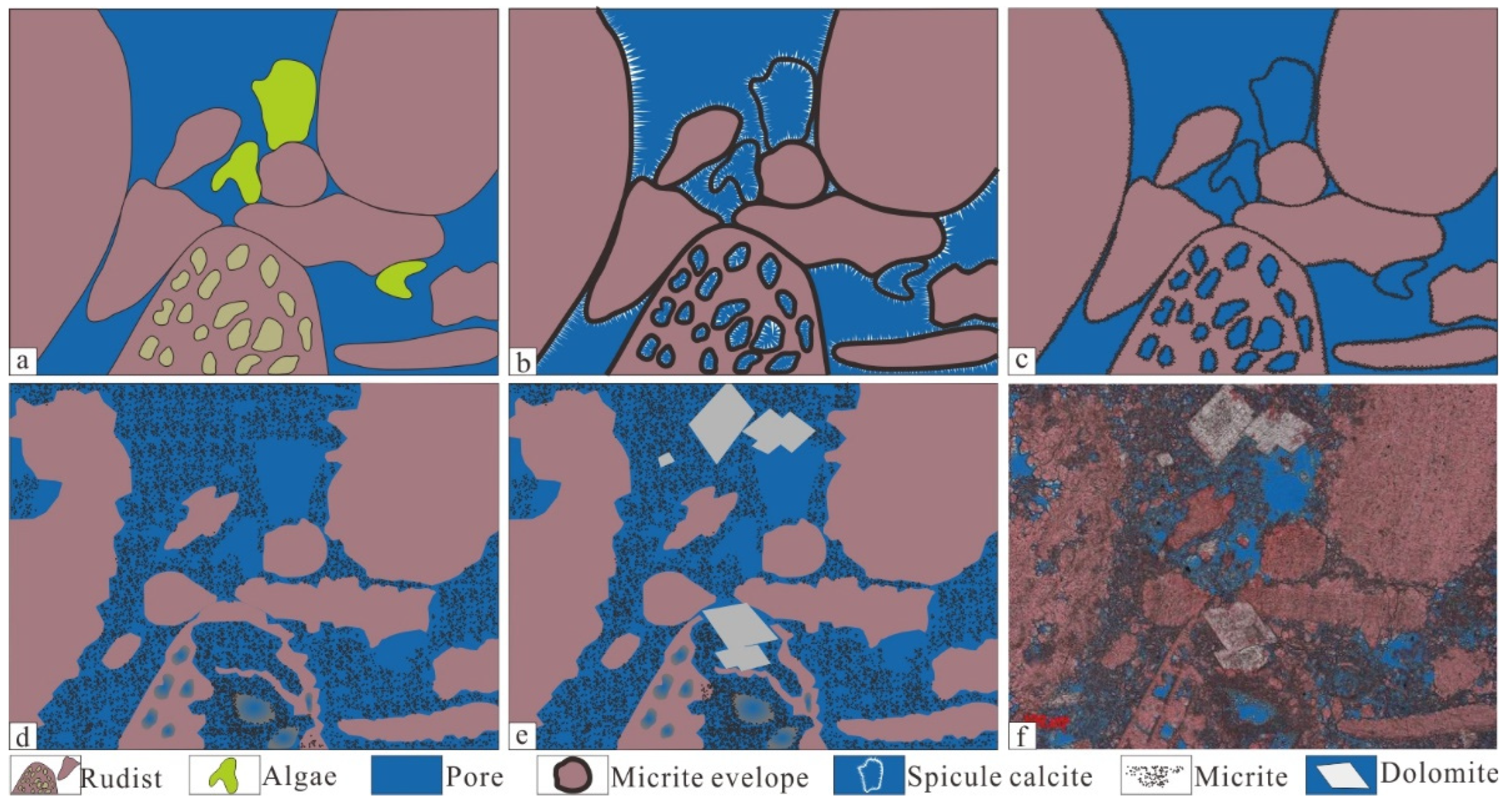
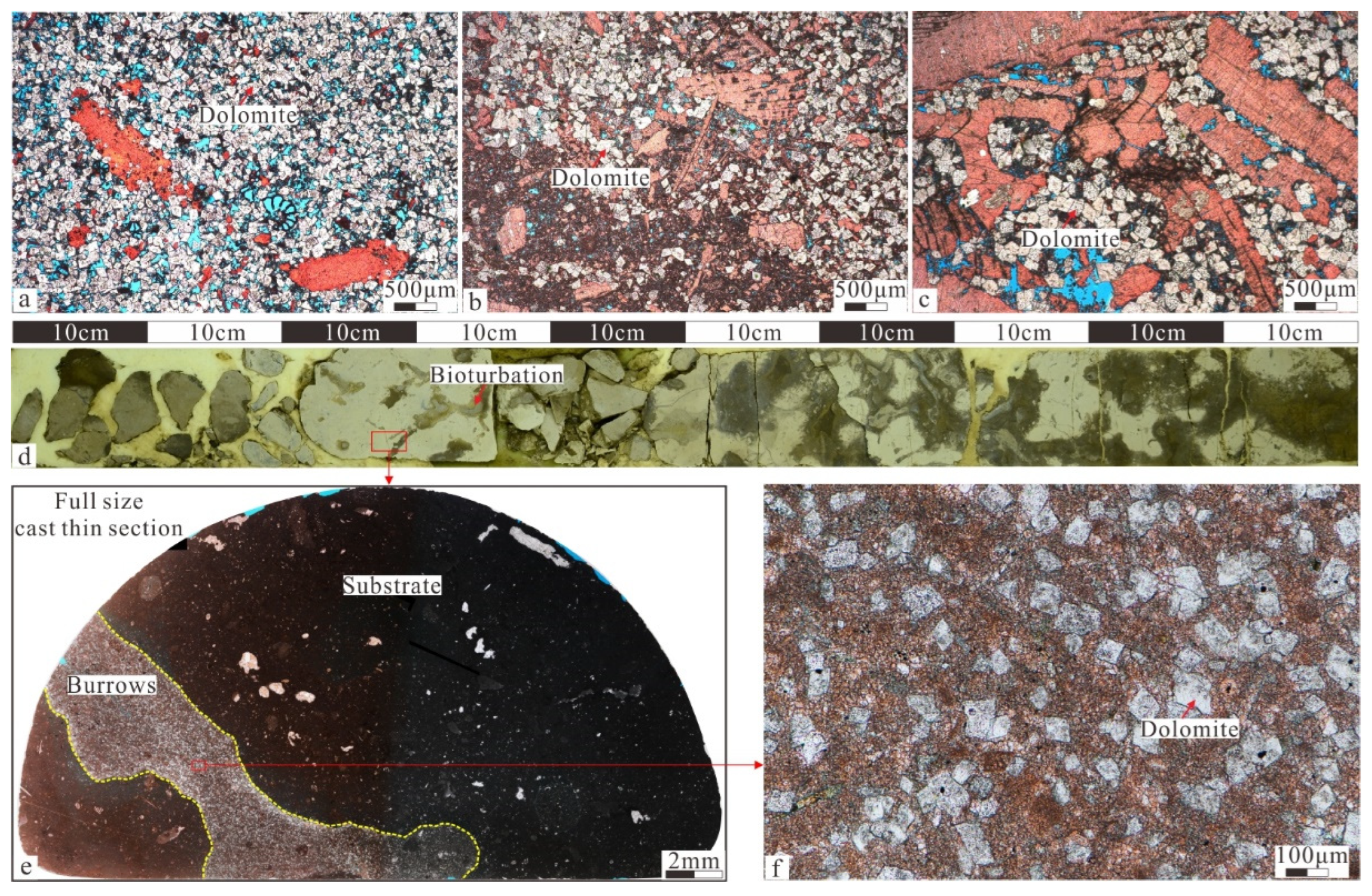
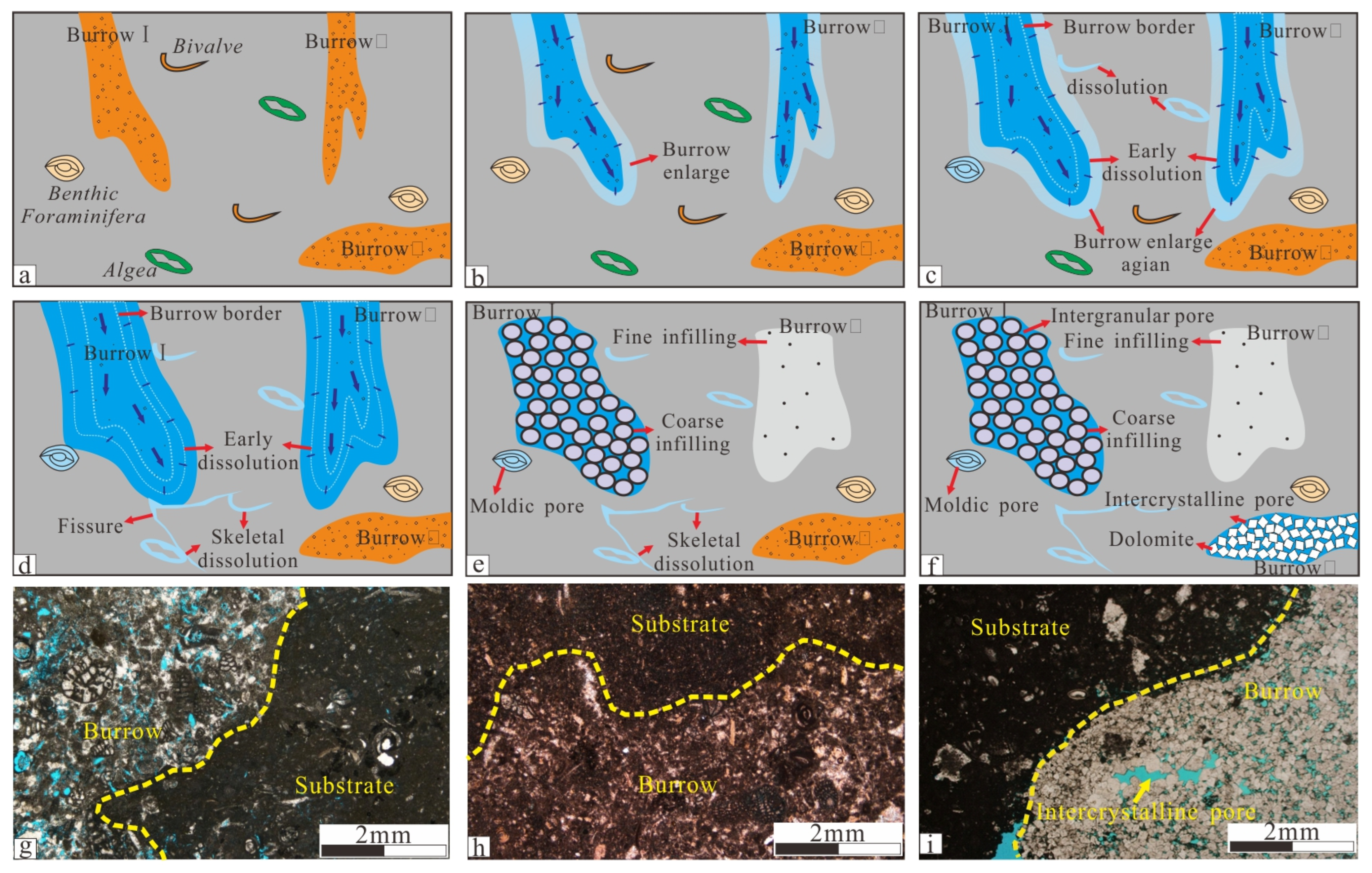
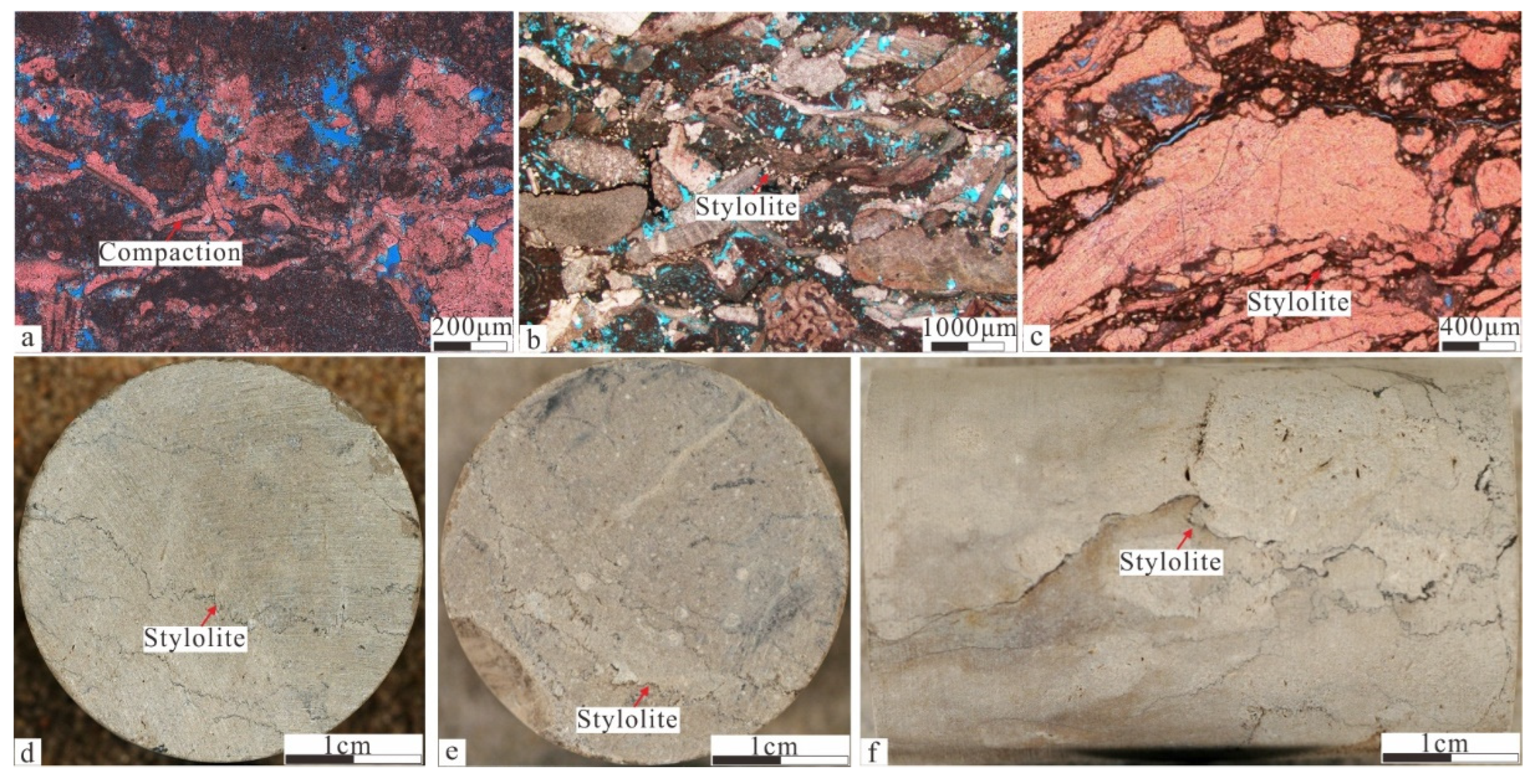
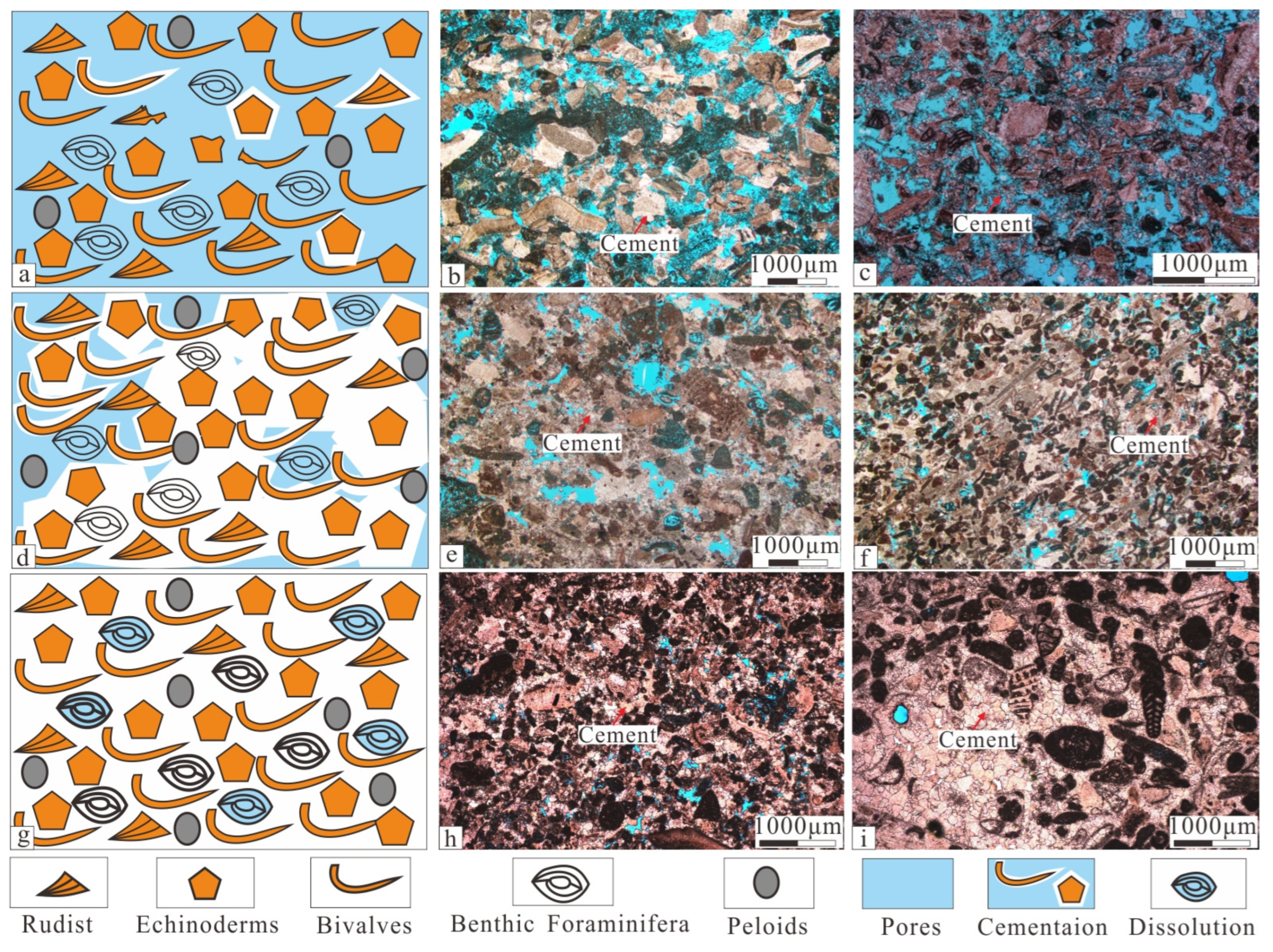
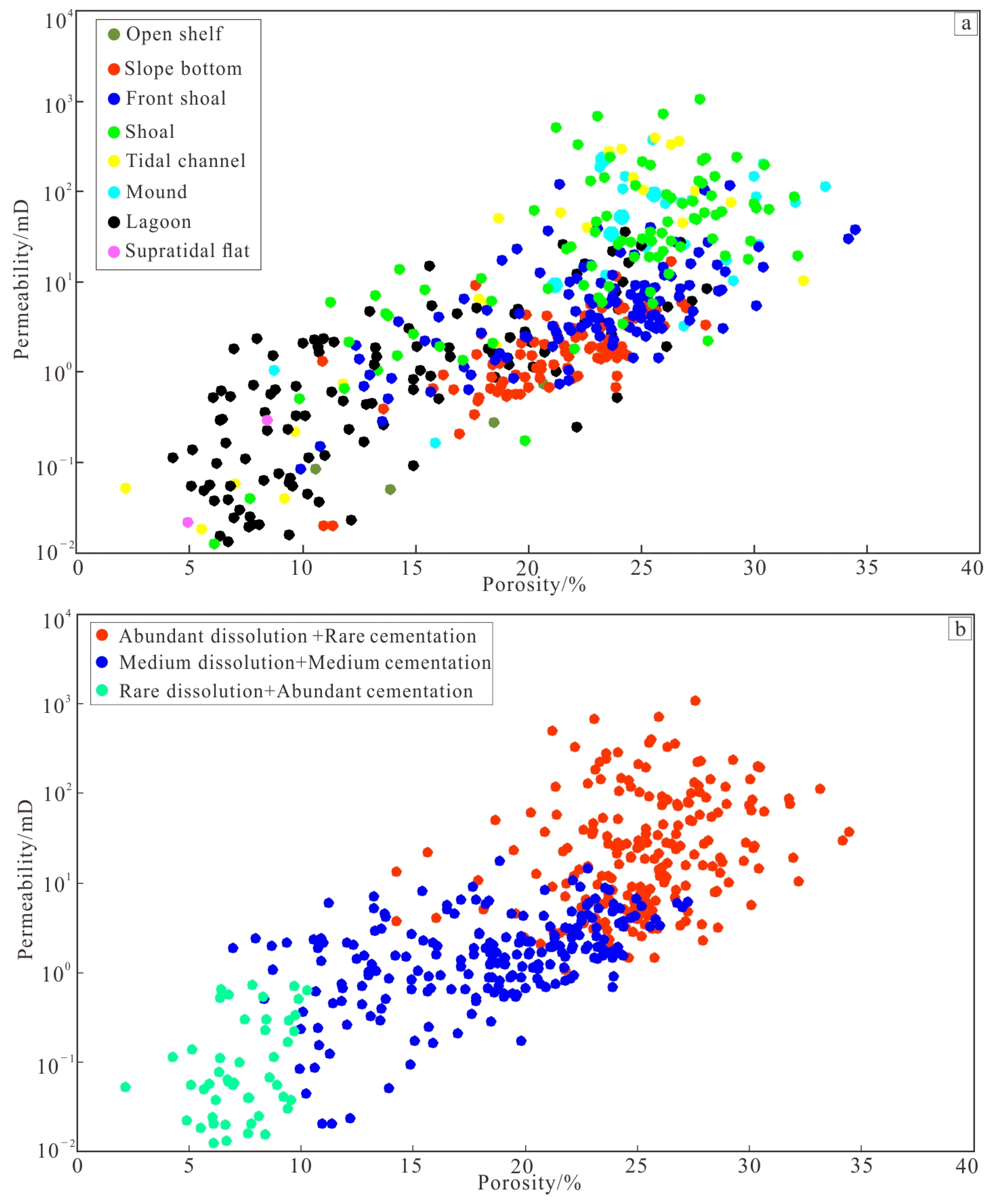
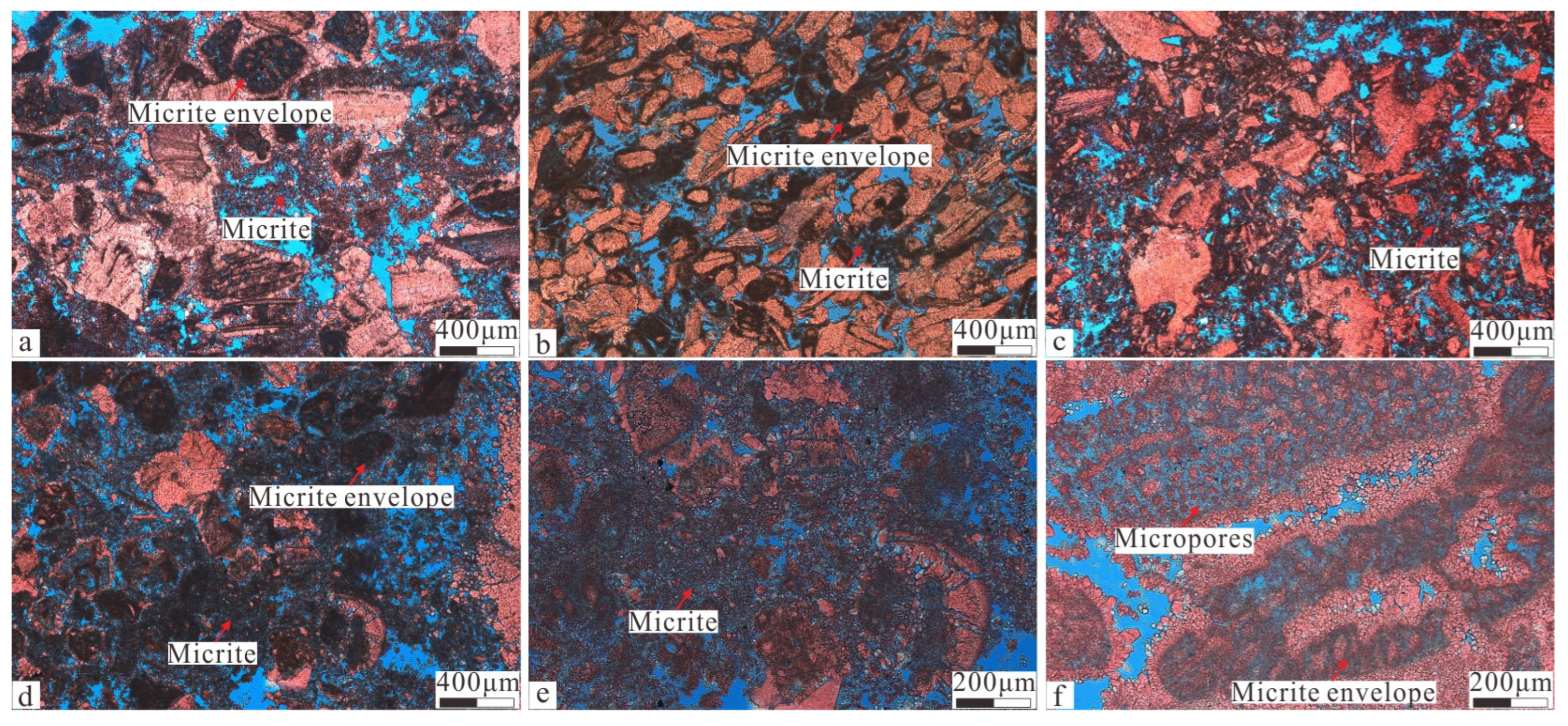

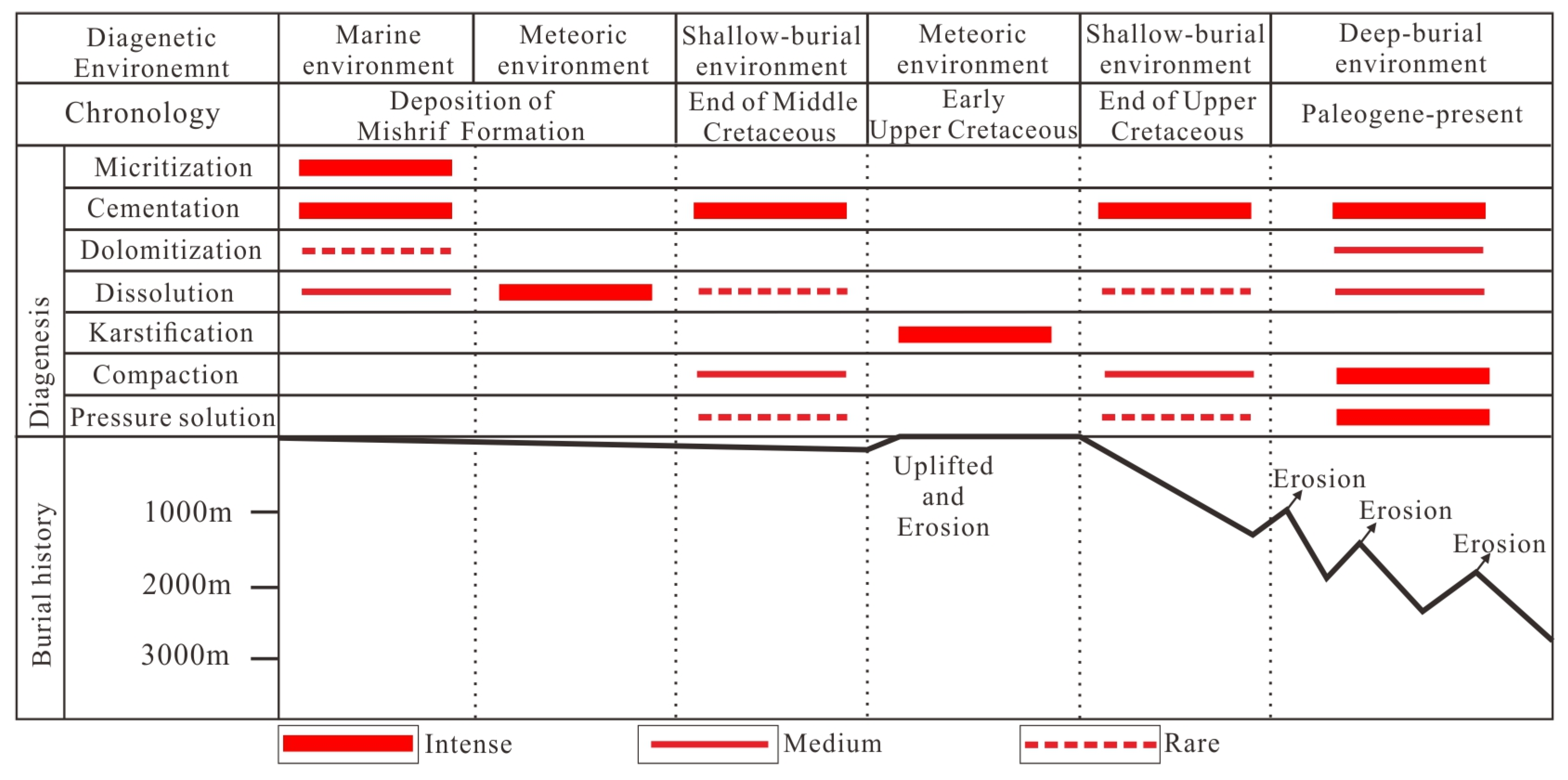
| Sample | Depth /m | Strata | Lithology | δ13C‰ (VPDB) | δ18O‰ (VPDB) | Precipitation Temperature (°C) |
|---|---|---|---|---|---|---|
| 1 | 2862.33 | Mishrif | Mudstone | 1.84 | −5.14 | 20.823 |
| 2 | 2864.71 | Mishrif | Wackstone | 2.64 | −4.59 | 20.820 |
| 3 | 2879.48 | Mishrif | Mudstone | 2.14 | −4.53 | 20.820 |
| 4 | 2919.33 | Mishrif | Packstone | 3.34 | −3.63 | 20.816 |
| 5 | 2921.77 | Mishrif | Mudstone | 2.76 | −3.91 | 20.817 |
| 6 | 2928.58 | Mishrif | Wackstone | 3.06 | −4.18 | 20.818 |
| 7 | 2935.81 | Mishrif | Wackstone | 2.90 | −3.83 | 20.817 |
| 8 | 2979.66 | Mishrif | Grainstone | 2.66 | −4.38 | 20.819 |
| 9 | 3003.18 | Mishrif | Grainstone | 3.97 | −5.43 | 20.824 |
| 10 | 3016.40 | Mishrif | Grainstone | 3.58 | −4.97 | 20.822 |
Disclaimer/Publisher’s Note: The statements, opinions and data contained in all publications are solely those of the individual author(s) and contributor(s) and not of MDPI and/or the editor(s). MDPI and/or the editor(s) disclaim responsibility for any injury to people or property resulting from any ideas, methods, instructions or products referred to in the content. |
© 2024 by the authors. Licensee MDPI, Basel, Switzerland. This article is an open access article distributed under the terms and conditions of the Creative Commons Attribution (CC BY) license (https://creativecommons.org/licenses/by/4.0/).
Share and Cite
Li, F.; Li, Y.; Han, H.; Zhang, W.; Li, L. Diagenesis of Cenomanian–Early Turonian and the Control of Carbonate Reservoirs in the Northern Central Arabian Basin. Minerals 2024, 14, 769. https://doi.org/10.3390/min14080769
Li F, Li Y, Han H, Zhang W, Li L. Diagenesis of Cenomanian–Early Turonian and the Control of Carbonate Reservoirs in the Northern Central Arabian Basin. Minerals. 2024; 14(8):769. https://doi.org/10.3390/min14080769
Chicago/Turabian StyleLi, Fengfeng, Yong Li, Haiying Han, Wenqi Zhang, and Lei Li. 2024. "Diagenesis of Cenomanian–Early Turonian and the Control of Carbonate Reservoirs in the Northern Central Arabian Basin" Minerals 14, no. 8: 769. https://doi.org/10.3390/min14080769






